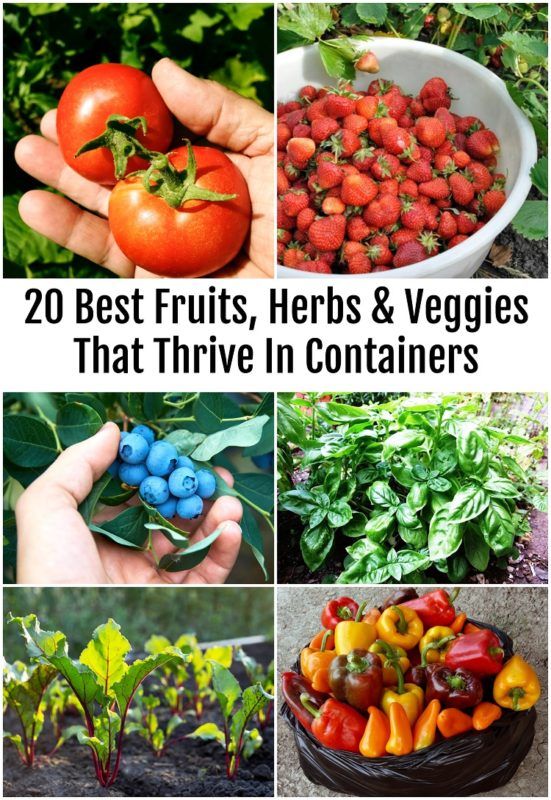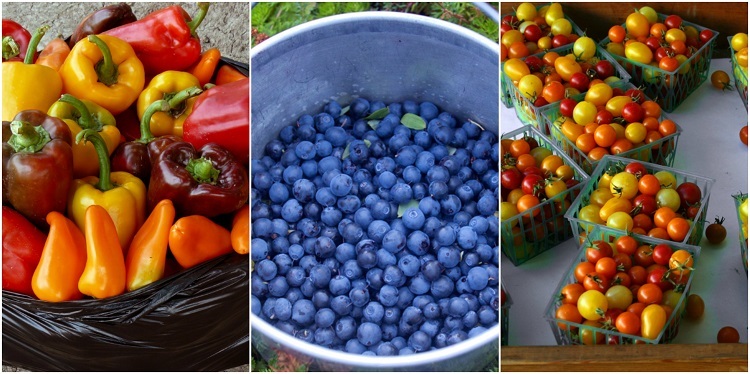
If you love fresh fruits, vegetables and herbs but don’t want to always drive to the grocery store to get them, consider container gardening. It is a rapidly expanding movement with the rising cost of food and people becoming more conscious of what they are eating. You now see apartment balconies lined with containers and even in the smallest of spaces, you can grow enough food for your family.
Having fresh and handy fruits, vegetables and herbs is not the only advantage to container gardening. In containers, you can grow exotic edibles, extend the growing season, and overcome zone limitations and space constraints. You know what you are eating, where it comes from and you will most likely have enough to share with others.
Container plants can be easily protected from pests and diseases. You have greater control over the nutrient supply; you can adjust their environment by moving them around: and give them spot treatments when necessary. It may be argued that any tree, shrub, or herbaceous plant can be grown in containers, but not all of them thrive in the limited space and give satisfactory results.
Here’s a selection of the best fruits, vegetables, and herbs for containers. They are chosen for ease of growing, consistent yield, and nutritional benefits.
Best Fruits For Container Culture
Fruit trees in containers are a long term investment. Since they will be growing in the same pot for years, you should choose large containers. Apart from good drainage and air circulation, the potting mixture should offer them long-term nutrition.
You can make your own potting mix from:
- 4 parts peat moss
- 6oz dolomite/gallon of peat moss
- 2 parts compost
- 2 parts perlite
- 2 parts sand
- 1 part garden soil
Add in 1 lb bone meal and osmocote/100 gallon of prepared potting mix.
Fill 1/3 of the containers with potting soil and place the plant inside. Fill in the sides, bringing the soil level up to 2/3 of the container. This will leave some space for top ups in the following years.
Recommended Reading: How To Make Your Own Super Powered Potting Soil
Meyer Lemon Tree
This pretty tree is the number one choice in fruit trees for pot culture because it never disappoints. It is hardy up to USDA Zone 8, providing year-round interest with its shiny, evergreen leaves, fragrant flowers and abundance of large, bright yellow fruits. Further north, this lemon tree should be overwintered indoors, a task made easier if the pot is kept on rollers for easy movement.
In a large container, Meyer lemons can grow over 6 feet, so occasional pruning is necessary to maintain them at the desired height. Grafted trees start bearing fruit in the second or third year. They require regular watering and feeding through the spring and summer. Thin out fruit clusters if you want larger fruit. Move them indoors before the first frost, and drastically reduce feeding and watering through fall and winter.
To speed up the process, you can purchase a Meyer lemon tree that’s ready to bare fruit in it’s first year.
Blueberries

Blueberries grow on shrubs that adjust very well to container culture and produce plenty of berries well known for their antioxidant power. Blueberries are ericaceous plants that do well in acidic soil. When you grow them in containers, it is possible to provide the right environment for them.
Blueberry plants need plenty of sun and water. However, they don’t want to be fed too often. One or two applications of an organic fertilizer in summer will take care of their nutritional needs for the entire year. To ensure fruit set, you should have two or more blueberry plants in the garden.
Read Next: How To Grow Buckets Full Of Blueberries
Strawberries

You don’t need a strawberry patch to grow these naturally spreading plants. When grown in containers, their sprawling habit is checked to some extent, leading to better fruit production.Grow them in tall containers so that the plant falls over the sides, giving you very high yield per sq ft.
They can sit indoors near a sunny window or under artificial lighting, and continue to grow and produce fruit as well. Keep harvesting the fruit and removing unwanted baby plants regularly to ensure continued growth. With a few ever bearing strawberry plants around, your fruit bowl will never be empty.
Read Next: How To Grow An Endless Supply Of Strawberries
Columnar apple
Apples of all kinds flood the market during the season, but it is fun to have your own tree to pluck a fully ripe apple straight off it and eat. Although it is possible to grow regular or dwarf varieties of apples in containers, columnar apple trees give the best results. For one thing, they don’t need pruning. The main upright stem bears several short branches called fruiting spurs that produce flowers and fruits.
Grow columnar apple trees in large containers with 5-10-gallon capacity. You should have more than one tree, and also choose varieties with chill hours that match your climate. A sunny location and regular water and feed are necessary.
Mulberry
Mulberries can be a tree or a bush depending on how they are allowed to grow. As a patio tree, the mulberry may not be a hit with homeowners because of the stain the ripe fruit can leave on floors. However, it is worth growing because of its sweet and tart flavor and potent nutritional profile.
Grow a dwarf variety in a large container and place it at arm’s length from your deck so that the mulberries don’t get a chance to ruin your floor, but you still have access to the delicious fruits. As an added bonus, these trees attract a large variety of birds too.
Passion fruit
The amazingly beautiful plant is a tropical perennial vine, but in the subtropics, it can be grown as an annual in large containers. Or you can cut it back close to the roots and keep it in the garage until next spring when it will sprout again.
The fast-growing passion fruit vine needs a sturdy trellis or other kind of support. Give plenty of water and occasional feeding to keep it happy and it will give you plenty of fruits to enjoy and giveaway.
Best Vegetables To Grow In Containers
As a general rule, all vegetables, except leafy vegetables, need plenty of sunlight, rich soil and continuous feeding. Almost all of them are grown as annuals, so you have to start with new seeds or seedlings every year.
Tomatoes
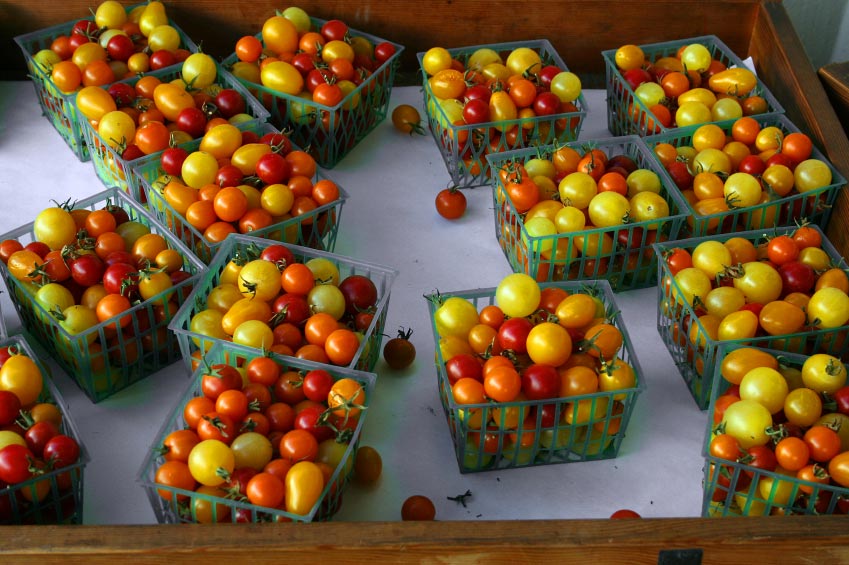
Growing tomatoes out in the garden gives you bumper crops in the season, but if you grow them in containers, you can get year round supply of fresh tomatoes. Large containers can take several plants, but you will need to use sturdy stakes or wire cages to support the plants.
Pot up your tomato plants in a rich soil and compost mix containing some slow release fertilizer like kelp meal, blood meal or fish emulsion. Give them plenty of sun and regular watering.
Read Next: 11 Secrets To Growing The World’s Tastiest Tomatoes
Bell Peppers
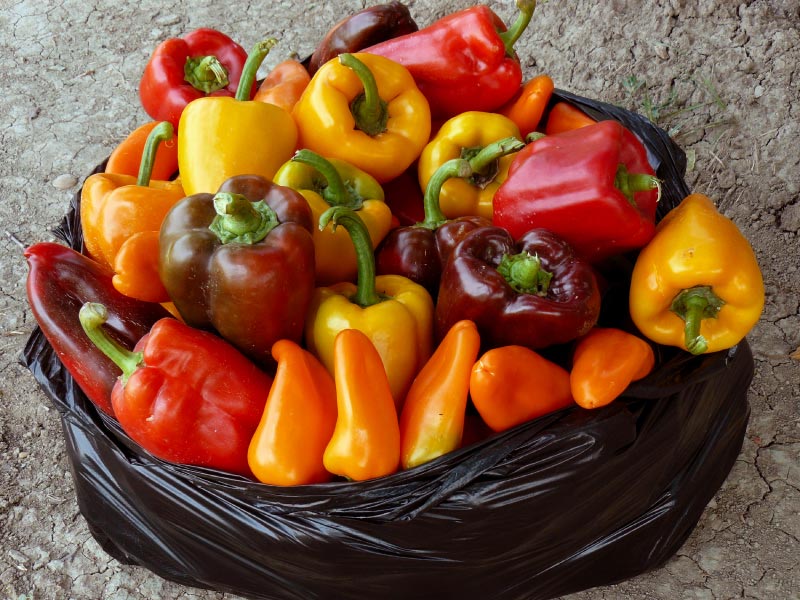
Bell peppers in different colors and sizes can be grown in pots throughout the year. It is best to grow small varieties in 2 gallon pots. You can keep them outside during the day to benefit from maximum sun exposure, but when the night temperature is too low, they can be brought inside.
You can increase the yield of pot grown peppers if you hand pollinate them. One way to do it is by taking a soft paintbrush to every open flower. Or you can help distribute the pollen by shaking the plant a few times a day when it is in flower.
Read Next: How To Grow A Bountiful Supply Of Bell Peppers
Cucumbers
Growing cucumbers in containers is a most rewarding experience even for first-time gardeners. Rich compost and plenty of water will aid their fast growth. You can train the vines along a string stretched across two poles or along the roof trim. Harvest cucumbers frequently to avoid weighing down the vines.
The bush type hybrids are a good bet because they are prolific bearers; you’ll have plenty of cucumbers for your salad bowl and a lot more for pickling and for giving away.
Potatoes
Potatoes are excellent for growing in containers, especially if you like to eat early spuds freshly dug up. Flexible containers like potato sacks or plastic grow bags that allow good drainage saves you a lot of digging later.
Fill the container with loose, well-draining potting mixture, but not more than half way up. You can top up when you see small potatoes forming on the roots near the surface. Plant one spud/gallon, so that a 5 gallon pot will have 5 plants. At harvest time, just shake the plant out of the soil or overturn the container on a plastic sheet.
Read Next: 7 Tricks To Growing Sacks Of Spuds
Carrots
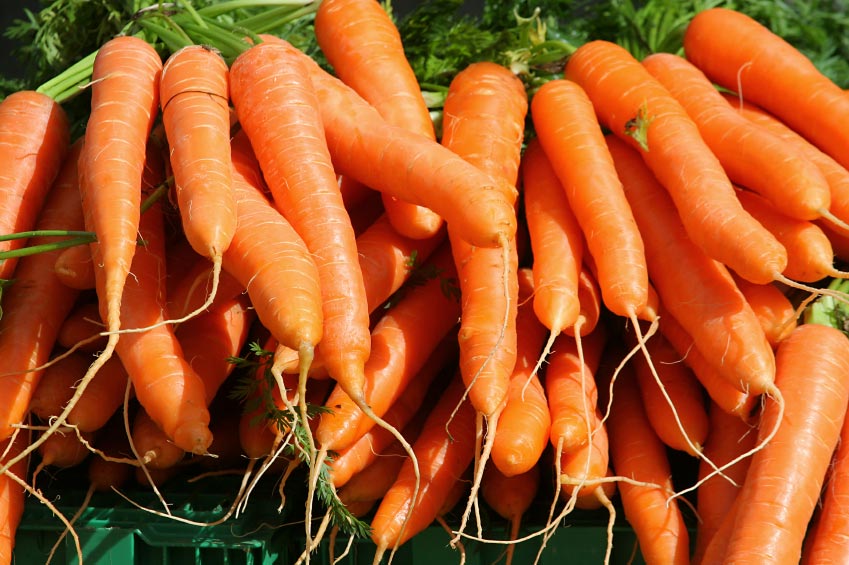
You can grow several rows of carrots in a large rectangular tub or have 2-3 per a smaller pot. Carrot plants prefer not to be disturbed, so the seeds are sown in situ. Make ½ inch depression 3-4 inches apart and sow 2- seeds in each. After a few true leaves appear, the weaker ones in each hole is snipped off close to the soil surface with a pair of sharp scissors. Don’t disturb the remaining plants by trying to pull off the seedlings.
When carrot tops become visible on the surface of the soil, top up with more soil to prevent them developing green tops. In about 2 ½ to 3 months, you may be able to harvest sweet and tender carrots.
Radishes
Radishes are great for container culture, especially for first-time gardeners who would be impatient to see results in the shortest possible time. Radish seeds are planted in situ and then thinned later.
Fill the pots with rich compost-based potting mix. Use 6” deep pots for rounded red varieties and deeper ones like paint buckets for the long white ones. Sow the seeds 2-3 inches apart. They will sprout in as little as 3 days and the tubers will be ready for harvest in about 30 to 35 days. You can start a batch every week to have fresh radishes for the salad bowl.
Beets

Beets can be grown easily in any kind of containers. You can use them for cooking or for pickling. The seeds are sown in situ because beets don’t take kindly to transplanting. Sow the seeds 3-4 inches apart, but thin them out later, if necessary. That should be done by snipping them off, not by pulling out the unwanted seedlings. Beet greens are edible, but they have high oxalic acid content.
Spinach
Spinach gives good yield across USDA Zones 5 to 10 as long as it is kept in cool shade in the warmer areas. When you grow it in pots, you can easily move it around. For instance, your spinach plants can go outside for some extra sun in spring and summer in places with a mild climate, but can be brought inside when it gets too cold. A sunny window should do in warm areas as too much heat will make the plants listless.
Sow the seeds 8” deep pots. One plant per pot is ideal to get big leaves and avoid diseases. A well-draining medium is essential because these plants like to have plenty of water, yet hate wet feet. To harvest, pull up the entire plant or pinch off lower leaves as new leaves develop.
Lettuce
If you love green salads, you will enjoy growing lettuce in containers. Use small pots to grow individual plants or long, rectangular boxes for a row of plants.
Frequent watering is important, as is a well-draining medium. There are many types of lettuces, from smooth and curly-headed ones to leafy ones. Sow the seeds in situ 6 inches apart and harvest leaves on a regular basis for the leafy ones. Cabbage-headed types should be harvested whole.
The Best Herbs To Grow In Containers
Being small plants with tender stems, most herbs lend themselves to container gardening. You can grow a good selection of these aromatic and flavorful plants by a sunny kitchen window, and snip off bits and pieces as and when you require them for your cooking.
Parsley
Parsley loves partial shade so they can be grown indoors round the year. Sow the seeds in a wide container and keep it near a bright window. If the seedlings are too crowded, you can thin them out and use them in some savory dishes. The flat-leaved parsley has a strong flavor compared to its curly-leaved cousin.
Basil
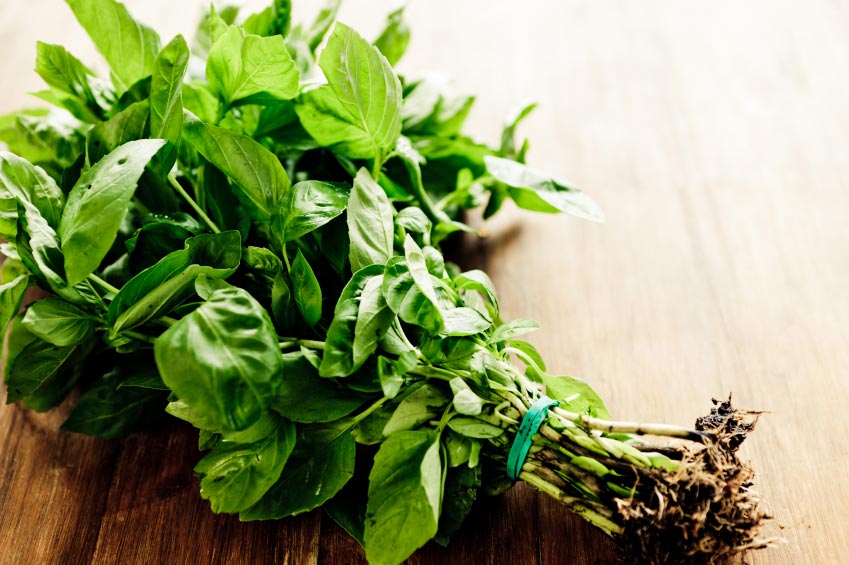
Basil prefers a bit of direct sunlight and warmth, so you can keep these plants outside when it is sunny, and then bring them indoors when the temperature falls. You need only one or two plants to provide all the basil leaves you’d ever need. Snip off the stem tips to keep the plant bushy and to prevent it from flowering.
Read Next: How To Grow A Giant Basil Bush – A Pro Gardener Reveals Their Secret
Oregano
The little leaves of oregano go a long way, so you need only one or two plants growing in small pots. Oregano plants enjoy being out in the sun every now and then, but you can overwinter the plants by bringing them indoors at night during the cold season.
Chives
Chives are such neat plants whether you grow them in pots or out in the garden. The thin, deep green leaves and the purplish-pink flowers make them a delightful and attractive plant to have in small pots. Out in the garden, they die off every year and come back again with renewed strength. But your container-grown plants can be kept going all year so that you can harvest the leaves and flowers any time for your soups and potato dishes.
Mint
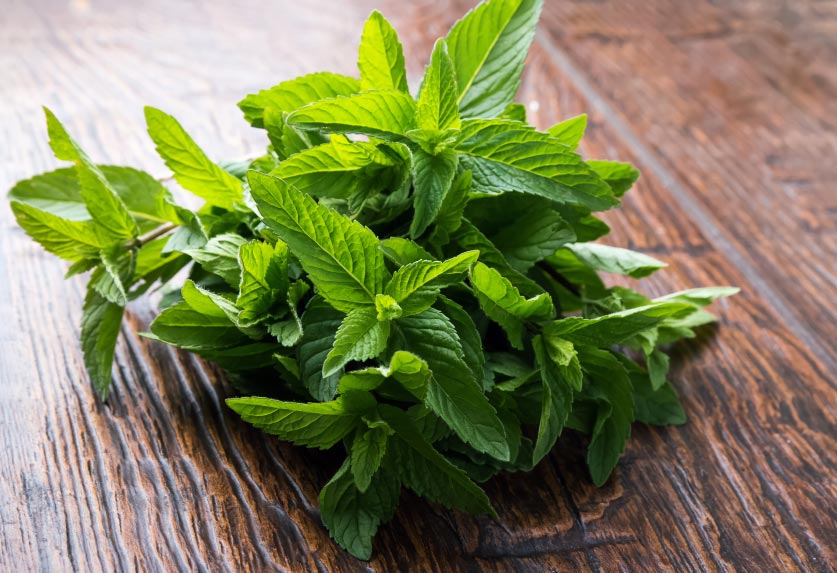
No one should be without a mint plant at arm’s reach. Just touching the leaves to release the fragrance is uplifting. Use the leaves to flavor lemonade or to make mint tea.
Mint plants love rich soil and plenty of water. It is always best to keep the mint plants in pots as they have the tendency to spread everywhere in the garden.
Remember to keep a constant watch over your potted edibles. Because of the limited amount of soil, they can dry out sooner than plants growing in the garden. Attend to diseases and pest attacks immediately. You might want to add a lot more vegetables and herbs to this list as you realize how easy and rewarding it is to grow your own food.
Pin This To Save For Later
